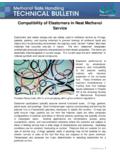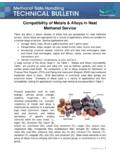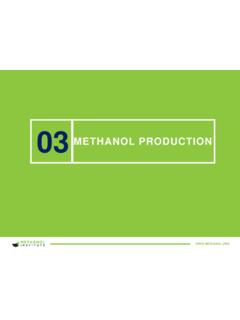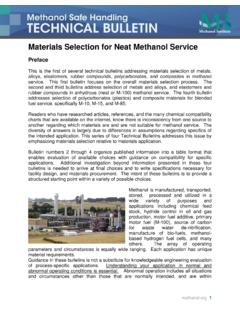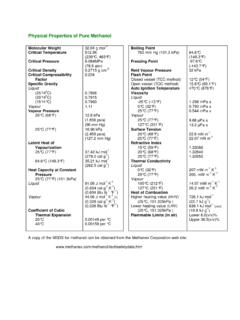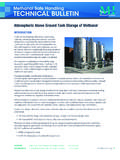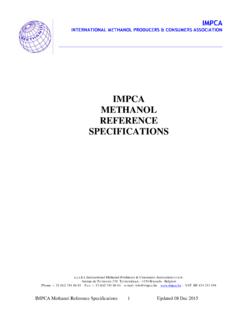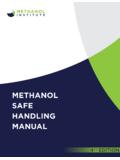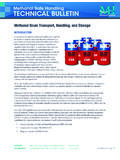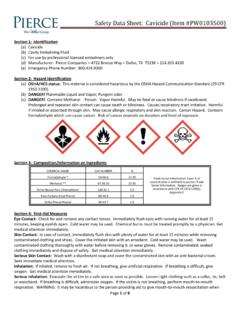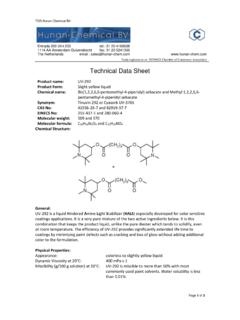Transcription of Oorja Protonics, Inc. Direct Methanol Fuel Cells
1 Oorja Protonics, Inc. Direct Methanol fuel Cells April 2016. 45473 Warm Springs Boulevard, Fremont, California 94539. 1-510-659-1899 | 1. Oorja Highlights Oorja is the first and only company manufacturing large, scalable Direct Methanol fuel Cells (DMFCs) with reliable fifth-generation products: Oorja has eight years of experience developing high-performance DMFC. stacks and fuel cell solutions. Methanol has many advantages over hydrogen in terms of safety, cost, storage weight, ease of availability, and transportation. Oorja is selling to several multi-billion dollar markets with strong customer demand: Wireless telecom: Providing clean and quiet back-up power for cellular base stations. Materials handling: Extending the battery range for forklifts and aviation scissor lifts. Back-up Power: Security, surveillance and military. Oil and Gas: Pipeline instrumentation and operations.
2 Future markets: Consumer and residential, emergency power (lights, buildings, shelters), micro grids, and distributed energy generation. 2. DMFC: Key Enabler of the Methanol Economy Methanol (CH3OH) can be made from: Coal*. Methane in natural gas Agricultural waste Animal waste-- Smithfield Farms hog waste Construction waste--lumber, plywood Forestry and forestry products waste Municipal solid waste Waste CO2 and atmospheric CO2. Methanol is available globally and is used for cooking, heating, lighting, and transportation. Oorja delivers clean, Methanol -based electrical power. * Steam-reformed coal is sometimes used as a feedstock for Methanol production, particularly in China (Source: Wikipedia). 3. How Does a Methanol fuel Cell Work? Converts chemical energy stored in Methanol into electricity. Produces usable water and heat as byproducts. Key benefits: Lower greenhouse gas emissions than fossil- fuel -based electricity production No SOx, NOx, or particulate emissions Operable 24/7.
3 Multiple applications as battery range extender 4. Products Overview Model-T. kW Net Power Applications: Telecom and Back-up applications Scalable fuel Tank, Modular Design, all in one solution Model-3. kW Net Power Applications: MHE, Mobile back-up Integrated fuel tank 12 liters, standalone Model-D (Releasing Q1: 2017). 500 Watts Net Applications: Portable Power, mobile standalone Built in Inverter and battery 5. Product Market Road Map: 2015 2019. Q4 Q1 Q4 Q4 Q3 Q3. 2015 2016 2016 2017 2018 2019. Model 3 T-1 D T-3 S M. Release Net kW kW 500 Watts 5 kW 100-300 > 10 kW. power Watts Target Class III Telecom Portable Telecom Consumer Distributed forklift and tower Auxiliary Military grid power market pallet base Power Unit Emergency loader station power Security micro- Cells Surveillance 6. Wireless Telecom Problems Wireless carriers need a solution to keep their cell sites operating in the event of an extended power outage.
4 Relying on battery banks only is not practical (need too many of them to cover long outages, takes space, requires more maintenance, etc.). Current solutions include diesel gen sets, which come with many shortcomings: fuel and generators get stolen. Generators require lots of maintenance, otherwise they do not start when needed. They tend to break down. Noise and pollution are increasingly viewed as unacceptable, especially in urban environments. Regional laws restricting use of Diesel Gensets 7. Advantages of Methanol fuel Cells for the Telecom Market Footprint: The space required for the same run time is considerably less for fuel Cells than for battery banks. Methanol fuel Cells do not require cooling like batteries, eliminating the need for spacious cooling systems. Methanol fuel cell systems are available as either standalone units similar in size to a small refrigerator (for applications like base stations), as units inserted into 19 racks, or in outdoor enclosures.
5 Operations: Methanol fuel Cells have few moving parts, reducing the need for regular maintenance. Unlike generators, Methanol fuel Cells do not use combustion; therefore, there are no NOx, SOx, or particulate emissions. Methanol fuel Cells operate as long as fuel is available, so an 8-hour, 1-day, or 3-day extended runtime can be enabled by storing the appropriate amount of fuel on site. fuel ( Methanol ): Operating Oorja fuel Cells requires industrial-grade Methanol , which is readily available and fairly cheap; easy to store; and with much lower infrastructure costs than hydrogen. Methanol is far less explosive/flammable than hydrogen or gasoline. 8. T-1 Systems Modular Units 9. Installations China Telecom 10. Installations Africa (Vodacom/MTN). 11. Installations Philippines (Globe/SMART). 12. Installations Scissors Lift 13. Installations Material Handling 14. Remote Power Units (Ensol Systems).
6 15. Materials-Handling Problems Forklifts slow down noticeably after 4 to 5 hours, causing a loss in productivity, often during rush time, when orders need to be shipped promptly. Forklifts can barely do one shift on one battery, but sometimes two or three shifts are needed. Changing batteries takes time (10 minutes) and requires additional and expensive batteries and charging stations (which also take warehouse space away from the storage of goods). The life of the batteries is shortened when they are deeply discharged. Operations come to a stop during extended power outages. Electricity costs are often determined based on peak power consumption, and forklifts are usually the main users of power in a warehouse. Sometimes there is no more space available to add additional forklifts as needed, affecting the ability to ship more; therefore any increased in productivity with the fuel Cells will translate into the ability of taking more orders.
7 16. DMFCs Reduce High CapEx and OpEx Costs for Powering Materials-Handling Forklifts, Pallet Loaders, etc. Equivalent space for Methanol refueling rig Battery Swapping Station Rapid Charging Station 17. Advantages of Methanol fuel Cells for Materials-Handling Class III Equipment Performance Increased productivity. No degradation of power over time. Without Oorja fuel Cells , forklifts slow down noticeably after 4 hours. Constant efficiency even at partial loads. Reduced downtime. Operation One person can be trained in a matter of hours to refuel the forklift, reducing the need for an additional operator. The required infrastructure requires significantly less footprint. Refueling is considerably quicker than the battery charging process. Eliminates the need for having extra batteries and chargers. Additional refueling points can be installed to reduce the distance travelled to refuel and the associated downtime.
8 Environmental Using Methanol there are no Direct harmful emissions no NOx, SOx, or particulates. Emits only water vapor and very small amounts of CO2 and Methanol . 18. Field Deployment Status Country Customer Market Segment Status SMART Telecom Trial Completed, negotiating purchase order Philippines GLOBE Telecom Trial Completed, negotiating purchase order Phillipines Navy Back-up Power Units Shipped, Trial to start in mid May Mexico Telcel Telecom Trial to start late May China Telecom Telecom Trial in progress China China Mobile Telecom Trial to begin in May China Tower Telecom Trial to begin in May Japan Toyota Tsusho Back-up Power/MHE Under evaluation Vodacom Telecom Trial in progress Africa MTN Telecom Trial in progress Accumentrics Back-up Power Signed agreement Baldor Foods MHE Follow on order completed Berry Engineering MHE Installation completed and received follow on order USA.
9 Siruis Integrator Security and Surveillance Under negotiation Apsara Networks High speed trading Under negotiation Airworks Cellular on Wheels Under negotiation Tata Power SED Military Under evaluation India Indus Tower Telecom Had initial meeting Aseem Oorja Military Putting together proposal for end customer Ensol Systems Security and Surveillance Certification and packaging process started Canada Total North Security and Surveillance Certification and packaging process started 19. Cost Reduction Roadmap $20, $18, System (Q1. $18, 2016): LCR parts Changed materials $16, New radiator Stack (Q2 2016): $14, design LCR graphite plates Electric Box (Q3 2016): Eliminated LCR manifolds New power bricks extra parts Radiators: Eliminate extra parts $14, Single radiator design LCR sourcing Outsourced design Stack: Stack (Q4 2016): Reduce number of MEAs Molded graphite plates Reduce number of graphite $12, Molded manifolds plates New MEAs $10, Sheet metal: Molded sheet metal $10, $9, MEAs (Q4.)
10 $8, 2017): $8, Oorja develops its own MEA. $6, $6, $4, $3, $4, $2, $2, $1, $1, $- Q4 2015 Q1 2016 Q2 2016 Q3 2016 Q4 2016 Q4 2017. BOM cost Cost Reduction Delta 20. Thank You Oorja Protonics, Inc. 21. Back-up Slides 22. How We Work with Our Customers - Field Test Plan Example 1. Select Trial Cell Sites: Conduct site technical assessment and selects trial site(s). 2. Oorja Recommended Solution: Based on Oorja 's Battery Range Extension Model, Oorja recommends a system design solution for the customer's problem. Oorja and the customer then agree on a trial plan. 3. In House Testing: Oorja validates the recommended design by conducting extensive in-house testing simulating the customer's trial site conditions; Oorja shares the resulting data with the customer. 4. Field Trial: Oorja 's design solution is then implemented at the selected sites; the customer and Oorja jointly conduct the trial over a 1- to 2-month (typical) period.

